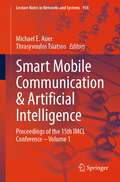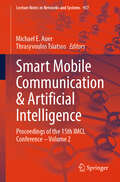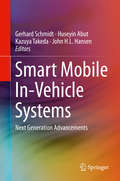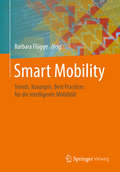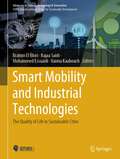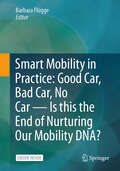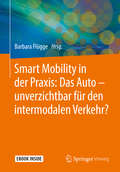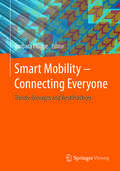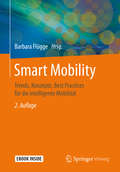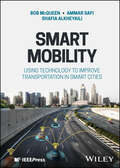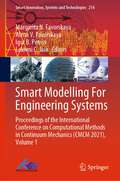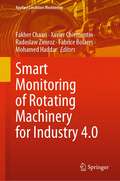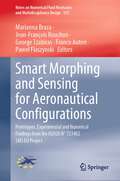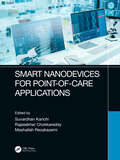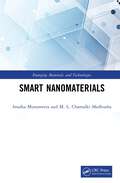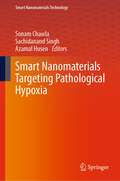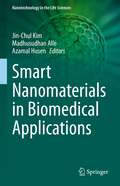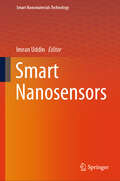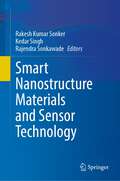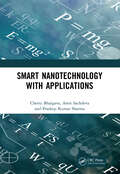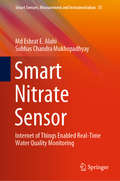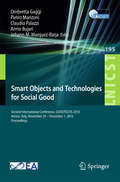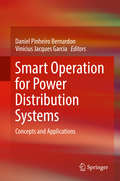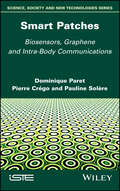- Table View
- List View
Smart Mobile Communication & Artificial Intelligence: Proceedings of the 15th IMCL Conference – Volume 1 (Lecture Notes in Networks and Systems #936)
by Michael E. Auer Thrasyvoulos TsiatsosInteractive mobile technologies are today the core of many—if not all—fields of society. Not only the younger generation of students expects a mobile working and learning environment. And nearly daily new ideas, technologies, and solutions boost this trend. To discuss and assess the trends in the interactive mobile field are the aims connected with the 15th International Conference on Interactive Mobile Communication, Technologies, and Learning (IMCL2023), which was held 9–10 November 2023. Since its beginning in 2006, this conference is devoted to new approaches in interactive mobile technologies with a focus on learning. Nowadays, the IMCL conferences are a forum of the exchange of new research results and relevant trends as well as the exchange of experiences and examples of good practice. Interested readership includes policy makers, academics, educators, researchers in pedagogy and learning theory, schoolteachers, learning Industry, further education lecturers, etc.
Smart Mobile Communication & Artificial Intelligence: Proceedings of the 15th IMCL Conference – Volume 2 (Lecture Notes in Networks and Systems #937)
by Michael E. Auer Thrasyvoulos TsiatsosInteractive mobile technologies are today the core of many—if not all—fields of society. Not only the younger generation of students expects a mobile working and learning environment. And nearly daily new ideas, technologies, and solutions boost this trend. To discuss and assess the trends in the interactive mobile field are the aims connected with the 15th International Conference on Interactive Mobile Communication, Technologies, and Learning (IMCL2023), which was held 9–10 November 2023. Since its beginning in 2006, this conference is devoted to new approaches in interactive mobile technologies with a focus on learning. Nowadays, the IMCL conferences are a forum of the exchange of new research results and relevant trends as well as the exchange of experiences and examples of good practice. Interested readership includes policy makers, academics, educators, researchers in pedagogy and learning theory, schoolteachers, learning Industry, further education lecturers, etc.
Smart Mobile In-Vehicle Systems
by Kazuya Takeda Huseyin Abut John H.L. Hansen Gerhard SchmidtThis is an edited collection by world-class experts, from diverse fields, focusing on integrating smart in-vehicle systems with human factors to enhance safety in automobiles. The book presents developments on road safety, in-vehicle technologies and state-of-the art systems. Includes coverage of DSP technologies in adaptive automobiles, algorithms and evaluation of in-car communication systems, driver-status monitoring and stress detection, in-vehicle dialogue systems and human-machine interfaces, challenges in video and audio processing for in-vehicle products, multi-sensor fusion for driver identification and vehicle to infrastructure wireless technologies.
Smart Mobility
by Barbara FlüggeDas Herausgeberwerk bietet einen umfassenden Zugang zum Trendthema Smart Mobility: ausgehend von sozio-ökologischen und sozio-ökonomischen Aspekten der Mobilität, den Anforderungen von Anbietern und Nachfragern bis hin zu Mobilitätsansprüchen ganzer Ökosysteme und der Anwendbarkeit digitaler Lösungen für die Lebensbereiche jedes Einzelnen. Das Buch setzt wirkungsvoll die Ausgangssituation im Bereich Mobilität in Kontext mit den unterschiedlichsten Nutzungsszenarien und Initiativen. Die Leserschaft erhält einen Fahrplan für die Mobilität in Zeiten der Digitalisierung: Bausteine Intelligenter Mobilität (BIM), ein Vorgehensmodell und eine Reihe praxisorientierter Handlungsempfehlungen erleichtern die Analyse-, Planungs- und Umsetzungsphasen von Mobilitätsvorhaben.Die Beschreibungen erfolgen bewusst anschaulich und nachvollziehbar durch Checklisten und Anleitungen. Damit richtet sich das Buch an alle Entscheider, Innovationstreiber und Vordenker aus der Praxis, die sich mit dem Thema Mobilität beschäftigen – sei es im Personen- oder Frachtverkehr.
Smart Mobility and Industrial Technologies: The Quality of Life in Sustainable Cities (Advances in Science, Technology & Innovation)
by Mohammed Essaaidi Rajaa Saidi Brahim El Bhiri Naima KaabouchThis book discusses many issues related to the impact of advanced technologies on quality of human life. It covers several areas and use cases that illustrate how technologies could be harnessed to solve all kinds of humanity issues in areas as diverse as education, health care, industry, agriculture, mobility, etc. Specially, it aims at establishing the vital link between advances in technology and sustainable development to magnify the benefits. This book covers a wide range of audience including academic/research, professors, scientists, and engineers working in different fields, comprising engineering, sustainability, as well as government and international organizations officials interested in sustainable planning. This is done through a set of selected papers from those presented to 4th International Conference on Advanced Technologies for Humanity (ICATH'2022) which was organized by the Moroccan School of Engineering Sciences (EMSI) in collaboration with national and international institutions. ICATH22 was held in Marrakech, from November 11 to 12, 2022. Key topics showcasing how technology can serve humanity in different ways and facets of human life, activities, and challenges are covered in depth through the chapters of this book which are presented in four different sections, namely:1. Advanced Technologies for smart Mobility in Smart Cities.2. Emerging Technologies for Connectivity in Sustainable Cities.3. Transitioning to Sustainable Industrial Engineering. 4. Technology for Human Sciences as Key Components of Sustainability.
Smart Mobility in Practice: Good Car, Bad Car, No Car – Is this the End of Nurturing Our Mobility DNA?
by Barbara FlüggeThis non-fictional, yet storytelling, book questions the role of cars and their impact, both for now and in the future. It is not enough to just consider autonomous driving, driving bans in Europe, and combustion engines. Our future and the future of our cities and country living depend on how we can coordinate different needs and different means. Finally, we ask ourselves: What is the status of the car today and in the future? Are we living and working in vehicles more than ever? And who benefits from autonomous driving and what are we giving up for it? In this book, the editor's work illustrates and critically assesses the role of cars. It showcases project examples and introduces easy to use checklists. The authors show how the car influences our business and private lives, and how the car stimulates our appetite for adventures, recreation, and survival. Emerging throughout more than a century, purposefully deployed, and innovativelyused, the automobile grew into our mobility DNA beyond horsepower and equipment. The car has been evolving into an adventure space, a survival and a growth space. The editor and authoring team present innovative services, digital use cases and smart data that are worth considering. The concept of Smart Mobility offers the possibility to retrieve the appropriate means of transport for individual and freight traffic in a forward-looking, digital, and intermodal way. Smart Mobility in practice: Good car, bad car, no car by DoktorB Barbara Fluegge and team is aimed at decision-makers and entrepreneurs, as well as project managers and their teams, in the context of smart city and digitail transformation projects. Numerous checklists and a comprehensive glossary make the book an important tool for practical use in pre- and post-preparation of projects and lectures in the field of Smart Mobility, Smart City, Smart Regions. Business Development and Digital Humanism.
Smart Mobility in der Praxis: Das Auto – unverzichtbar für den intermodalen Verkehr?
by Barbara FlüggeDie Zukunft der Städte und Ballungsräume hängt zunehmend davon ab, wie Verkehrsteilnehmer ihre unterschiedlichen Bedürfnisse koordinieren. Das Konzept der Smart Mobility bietet die Möglichkeit, die geeigneten Transportmittel für Individual- und Frachtverkehr vorausschauend, digital und intermodal abzurufen. Davon profitieren die Verkehrsteilnehmer, aber auch unser Ökosystem. Dieses Fachbuch wirft einen Blick hinter das Konzept einer durch Digitalisierung gestützten intelligenten Mobilität. Es illustriert Vorgehensweisen und Fragestellungen anhand von fiktiven wie realitätsnahen Projektierungsbeispielen in Städten und Regionen und behandelt zentrale Fragen: Wie lassen sich Mobilitätsszenarien ganzheitlich einschätzen und erfassen? Welches sind die wesentlichen Schritte, die es dabei zu berücksichtigen gilt?Das Einführungskapitel stellt das Konzept „Smart Mobility“ vor und erläutert verschiedene Projektierungsansätze sowie die Bausteine Intelligenter Mobilität (BIM). Zehn Fallbeispielen, unter anderem zum Autonomen Fahren, zu intelligenten Verkehrsknotenpunkten, zum Erlebnisraum Auto und der E-Mobilität, zeigen praxisnah, wie die Tools, Vorgehensweisen und BIM anzuwenden sind. Zahlreiche Checklisten und Abbildungen unterstreichen darüber hinaus den Praxisbezug dieses Werkes. Das Begleitbuch zu „Smart Mobility“ von Barbara Flügge, Digitalisierungsexpertin und Beraterin, richtet sich an Entscheider und Unternehmer sowie an Projektleiter und -mitarbeiter im Rahmen von Smart-City-Vorhaben. Außerdem eignet sich dieser Band ideal zur Vor- und Nachbereitung von Lehrveranstaltungen zu Themen wie Smart Cities oder Urban Systems Research.
Smart Mobility – Connecting Everyone
by Barbara FlüggeThis book presents a comprehensive overview of various aspects of mobility and transportation to be smart and seamless. It provides basic principles and trends of smart mobility as well as international examples. The topic of this work is especially interesting as the future of human centered and business triggered ecosystems is increasingly dependent on the coordination capabilities of all participating and influencing members to manage transportation needs. Even more the fulfillment of the right to mobility for individual and cargo related mobility asks for mobility enablement in a predictive, digital and intermodal manner. Therefore, this book is useful not only for decision makers in several positions but also for people who are interested in trends of transportation and mobility.
Smart Mobility: Trends, Konzepte, Best Practices für die intelligente Mobilität
by Barbara FlüggeMit diesem Buch gelingt der Einstieg in das Trendthema „Smart Mobility“Dieses Buch bietet Ihnen einen umfassenden Zugang zum aktuellen Trendthema Smart Mobility. Die thematisch vielfältigen Beiträge maßgeblicher Expertinnen und Experten – zusammengetragen von Herausgeberin Barbara Flügge – beleuchten u. a. folgende Schwerpunkte:• Sozio-ökologische und sozio-ökonomische Aspekte der Mobilität• Die Anforderungen von Anbietern und Nachfragern• Mobilitätsansprüche ganzer Ökosysteme (Stadt, Land und Ballungsräume)• Anwendbarkeit digitaler Lösungen für die Lebensbereiche jedes EinzelnenMit diesem Setup setzt das Buch wirkungsvoll die Ausgangssituation in der Smart Mobility in den Kontext von unterschiedlichsten Nutzungsszenarien und Initiativen. Die Beiträge erläutern einzelne Bausteine Intelligenter Mobilität (BIM) und Vorgehensmodelle. Zudem liefert Ihnen dieses Herausgeberwerk zahlreiche praxisorientierte Handlungsempfehlungen und Best Practices, die Ihnen die Analyse-, Planungs- und Umsetzungsphasen von Mobilitätsvorhaben erleichtern. Damit richtet sich dieses Buch über Smart Mobility in erster Linie an:a) Chief Digital Officersb) Entscheider in öffentlichen Verwaltungen und in der Privatwirtschaftc) Innovationstreiber und Entrepreneure aus der Praxis d) Projektleiter und -mitarbeiter – sei es im Personen- oder FrachtverkehrDie Gegenwart und Zukunft im BlickUm Ihnen den Einstieg zu erleichtern, geben Ihnen die Beiträge zunächst einen Überblick über das große Themenfeld der Smart Mobility. Hier erfahren Sie, welche Vorgehensweisen sich zur Bewertung von Mobilität eignen, wodurch sich das Kauf- und Nutzverhalten im Personenverkehr heutzutage auszeichnet und wie Sie ein sicheres sowie nachhaltiges Verkehrsmanagement gestalten können. Weitere inhaltliche Schwerpunkte dieses Buchs sind:• Indoor- und Outdoor-Navigation in Smart Mobility-Szenarien• Inter- und multimodale Routenplanung• Smart Ticketing• Mobilitätsrelevante Diagnostik• Bausteine Intelligenter Mobilität für die Zukunft• Das Smart Mobility VorgehensmodellEin umfassendes GrundlagenwerkMit der zweiten aktualisierten Auflage bringt Ihnen dieses Buch den Themenkomplex der Smart Mobility anschaulich und nachvollziehbar näher. Die inhaltliche Mischung aus theoretischem Basiswissen sowie aktuellen Trends (wie z. B. Mega Cities oder Zero Traffic) und hilfreichen Checklisten machen dieses Werk zu einem nachvollziehbaren und anschaulichen Grundlagenwerk für alle Themeninteressierten.
Smart Mobility: Using Technology to Improve Transportation in Smart Cities
by Bob McQueen Ammar Safi Shafia AlkheyailiComprehensive learning resource providing a framework for successful application of advanced transportation technologies in urban areas Smart Mobility: Using Technology to Improve Transportation in Smart Cities addresses the nature and characteristics of smart cities, providing a focus on smart mobility within urban areas and the opportunities and challenges associated with the application of advanced transportation technologies. The three highly qualified authors include an emphasis on decarbonization possibilities and the potential for smart mobility to reduce emissions and fuel consumption while optimizing modal use, along with risk identification and management using a structured approach. A focus is also placed on the need for end-to-end travel support from origin to ultimate destination, reflecting consumer needs for comprehensive decision support and travel support services. Overall, Smart Mobility provides a framework, planning, and KPIs for smart mobility success and explains how effective performance management can be enabled. Additional topics covered in this modern and thought-provoking work include: Policies and strategies associated with smart mobility, including a description of the organizational arrangements required to support smart mobility technologiesThe definition of appropriate institutional, funding, and commercial arrangements to assist interested practitioners to solve what is often their biggest challengeCoverage of smart mobility operational management, explaining the likely impact of smart mobility on transportation operationsHow to attain balance between transportation objectives and the avoidance of undesirable side effects such as congestion For public and private sector professionals in the smart mobility community, Smart Mobility is an essential and easy-to-understand learning resource that will help readers comprehend the state-of-the-art progress in the field and be prepared for future advancements in this important and rapidly-developing industry.
Smart Modelling For Engineering Systems: Proceedings of the International Conference on Computational Methods in Continuum Mechanics (CMCM 2021), Volume 1 (Smart Innovation, Systems and Technologies #214)
by Lakhmi C. Jain Margarita N. Favorskaya Alena V. Favorskaya Igor B. PetrovThis book is a collection of research papers selected for presentation at the International Conference on Smart Computational Methods in Continuum Mechanics 2021, organized by Moscow Institute of Physics and Technology and the Institute for Computer Aided Design of Russian Academy of Sciences. The work is presented in two volumes. The primary objective of the book is to report the state-of-the-art on smart computational paradigms in continuum mechanics and explore the use of artificial intelligence paradigms such as neural nets, and machine learning for improving the performance of the designed engineering systems. The book includes up-to-date smart computational methods which are used to solve problems in continuum mechanics, engineering, seismic prospecting, non-destructive testing, and so on. The main features of the book are the research papers on the application of novel smart methods including neural nets and machine learning, computational algorithms, smart software systems, and high-performance computer systems for solving complex engineering problems. The case studies pertaining to the real-world applications in the above fields are included. The book presents a collection of best research papers in English language from some of the world leaders in the field of smart system modelling and design of engineering systems.
Smart Modelling for Engineering Systems: Proceedings of the International Conference on Computational Methods in Continuum Mechanics (CMCM 2021), Volume 2 (Smart Innovation, Systems and Technologies #215)
by Lakhmi C. Jain Margarita N. Favorskaya Alena V. Favorskaya Igor B. PetrovThis book is a collection of research papers selected for presentation at the International Conference on Smart Computational Methods in Continuum Mechanics 2021, organized by Moscow Institute of Physics and Technology and the Institute for Computer Aided Design of Russian Academy of Sciences. The work is presented in two volumes. The primary objective of the book is to report the state-of-the-art on smart computational paradigms in continuum mechanics and explore the use of artificial intelligence paradigms such as neural nets and machine learning for improving the performance of the designed engineering systems. The book includes up-to-date smart computational methods which are used to solve problems in continuum mechanics, engineering, seismic prospecting, non-destructive testing, and so on. The main features of the book are the research papers on the application of novel smart methods including neural nets and machine learning, computational algorithms, smart software systems, and high-performance computer systems for solving complex engineering problems. The case studies pertaining to the real-world applications in the above fields are included. The book presents a collection of best research papers in English language from some of the world leaders in the field of smart system modelling and design of engineering systems.
Smart Monitoring of Rotating Machinery for Industry 4.0 (Applied Condition Monitoring #19)
by Fakher Chaari Mohamed Haddar Radoslaw Zimroz Xavier Chiementin Fabrice BolaersThis book offers an overview of current methods for the intelligent monitoring of rotating machines. It describes the foundations of smart monitoring, guiding readers to develop appropriate machine learning and statistical models for answering important challenges, such as the management and analysis of a large volume of data. It also discusses real-world case studies, highlighting some practical issues and proposing solutions to them. The book offers extensive information on research trends, and innovative strategies to solve emerging, practical issues. It addresses both academics and professionals dealing with condition monitoring, and mechanical and production engineering issues, in the era of industry 4.0.
Smart Morphing and Sensing for Aeronautical Configurations: Prototypes, Experimental and Numerical Findings from the H2020 N° 723402 SMS EU Project (Notes on Numerical Fluid Mechanics and Multidisciplinary Design #153)
by Marianna Braza Pawel Flaszynski Jean-François Rouchon George Tzabiras Franco AuteriThis book reports on advanced strategies to design, modeling and testing morphing wings for aeronautical applications. Covering the major outcomes of the multidisciplinary project “Smart Morphing & Sensing” (H2020 N° 723402 SMS), funded by the European Union between 2017 and 2020, it presents a complete set of theories and methods that have been used and developed to integrate novel electroactive actuators and sensors in wings, for the purpose of increasing their aerodynamic efficiency and attenuate vibrations and noise. Topics include: integrated aeroelastic design of morphing wings using high-fidelity computational fluid dynamics and structural mechanics, distributed sensing using a new generation of high-fidelity fiber optics sensors, and controller design by appropriate flight control commands. Further, the book reports on advanced experimental techniques to validate novel actuation and sensing systems on the built prototypes via wind tunnel tests at subsonic (take-off and landing) and transonic (cruise) speeds. All in all, this volume provides readers with extensive and timely information on research and developments of bioinspired aircraft wings.
Smart Nanodevices for Point-of-Care Applications
by Suvardhan Kanchi, Rajasekhar Chokkareddy and Mashallah RezakazemiSmart Nanodevices for Point-of-Care Applications examines the latest trends on the capabilities of nanomaterials for point-of-care (PoC) diagnostics and explains how these materials can help to strengthen, miniaturize, and improve the quality of diagnostic devices. A thorough explanation of all-in-one nanosmart devices is included, incorporating all of the applications and fundamentals of these smart devices. This book provides practical information on the following: novel and effective smart materials, better-quality health management, effective management of a disease, potential point-of-care devices, and mobile nanosensors. Additional Features Includes in-depth research based collation of the latest trends of smart devices Provides practical information on all-in-one nanosmart devices Explains how nanomaterials can help to strengthen and improve the quality of diagnostic devices Emphasizes the development of smart nanodevices, especially the miniaturization aspect
Smart Nanomaterials (Emerging Materials and Technologies)
by Imalka Munaweera M. L. MadhushaSmart nanomaterials are the basis of diverse emerging applications, and this book covers their technological advances, innovations, and practical applications. It covers advances in the most critical aspects in chemistry and material fabrication of nanomaterials including engineering/prospective applications. The application of smart nanomaterials in the biomedical field, agriculture, food industry, and apparel industry is covered with practical examples. It discusses the future of smart nanomaterials and the pros and cons associated with smart nanomaterials in a detailed manner. Features: Reviews synthesis methods, characterization techniques, and applications of smart nanomaterials. Explores the significance of using smart nanomaterials in futuristic life including examples. Covers bionsensor sensitivity, selectivity, and stability for long-term operation and nanotechnology technique for possibly detecting hazardous viruses. Provides the manufacturing advantages, energy and electronic advantages, medical benefits, environmental effects, and economic issues. Explains risk assessment on humans in detail. This book is aimed at researchers and graduate students in nanomaterials and materials science.
Smart Nanomaterials Targeting Pathological Hypoxia (Smart Nanomaterials Technology)
by Azamal Husen Sachidanand Singh Sonam ChawlaThe book showcases the newest research on smart nanoplatforms responding to “hypoxia”; an omnipresent pathological feature of many modern-day diseases and its potential applications. The book demonstrates the versatility of hypoxia targeted smart nanoplatforms in disease management in diverse pathological settings presented in chapters contributed by various experts in the field. The themes in the book touch upon critical facets to address pathological hypoxia such as nanomaterials enhancing oxygenation, hypoxia responsive nanoformulations which deliver the drug directly to the hypoxic site, limited toxicity and enhanced efficacy of smart nanoformulations to counter molecular consequences of hypoxia, and theranostics combining hypoxia detection systems with drug delivery systems. This book disseminates the current implications of smart nanomaterials in disease management that can be exploited by scholars, researchers, and pharma industries to develop, manufacture, and commercialize hypoxia targeted diagnostics and therapeutics.
Smart Nanomaterials in Biomedical Applications (Nanotechnology in the Life Sciences)
by Azamal Husen Jin-Chul Kim Madhusudhan AlleWith the start of 2020, the wrath of pandemic challenged the scientific community to develop more advanced drug delivery approaches for biomedical applications, endowing conventional drugs with additional therapeutic benefits and minimum side effects. Although significant advancements have been done in the field of drug delivery, there is a need to focus towards strategizing novel and improved drug delivery systems that should be convenient and cost-effective to the patients, and simultaneously they should also provide financial benefits to pharmaceutical companies. Controlled drug delivery technology offers ample opportunities and scope for improvising the therapeutic efficacy of drugs via optimizing the drug release rate and time. For this endeavour, smart nanomaterials have served as remarkable candidates for biomedical applications, owing to their ground-breaking properties and design. The development of such nanomaterials requires a broad knowledge related to their physio-chemical properties, molecular structure, mechanisms by which the nanomaterials interact with the cells, and methods by which drugs are released at the site of action. This knowledge must also be allied with the knowledge of signaling crosstalk mechanisms that are modulated by the nanomaterial-drugs composite. It can be anticipated that these emerging drug delivery technologies can facilitate the world to successfully encounter such pandemic outbursts in the future in a cost-effective and time-effective manner. The chapters in this book deal with the advanced technologies and approaches that can benefit advanced students, researchers, and industry experts in developing smart and intelligent nanomaterials for future biomedical applications, and development, manufacturing, and commercialization for controlled and targeted drug delivery.
Smart Nanosensors (Smart Nanomaterials Technology)
by Imran UddinThis book serves as a comprehensive compilation of contemporary research conducted in the domain of nanosensors. The amalgamation of many elements within the emerging field contributes to the development of a useful collection specifically designed for inexperienced researchers in the domain of smart materials and nanosensor technologies. An adequate range of subjects has been incorporated into the present book. It includes enzyme-mimetic use of smart nanomaterials for enhanced biosensing applications, theranostic utilization of smart nanomaterials for targeted drug delivery, sensors for pollutant detection, and the utilization of smart nanomaterials in the development of biosensors for studying host-microbe interactions. Nanosensors have emerged as a promising avenue for various applications, including sensing in the fields of medicine, packaging, and heavy metal ion detection. Recent developments in the field of smart nanomaterials have led to significant advancements in the application of intelligent switches and sensors within the domains of agriculture, food production, and water treatment. The primary emphasis of this book is the study of the synthesis and fabrication processes involved in the production of smart materials, together with their application within the domain of sensor technology. The existing body of literature has two main categories: introductory textbooks that provide fundamental knowledge about the field and specialized publications that focus exclusively on certain subtopics within the domain of sensor technology. The existing material of the book makes it a complete reference resource that is well-suited for researchers in the area. It especially caters to advanced graduate students who are seeking senior graduate, MTech, and MS degrees in the subject of sensor technology. Additionally, this publication would function as an essential resource for researchers across diverse disciplines within the area of materials science who are aiming to propel the development of smart materials.
Smart Nanostructure Materials and Sensor Technology
by Rakesh Kumar Sonker Kedar Singh Rajendra SonkawadeThis book highlights the significance and usefulness of nanomaterials for the development of sensing devices and their real-life applications. The book also addresses various means of synthesizing 2D/3D nanomaterials, e.g., hydrothermal deposition process, electrospinning, Ostwald ripening, sputtering heterogeneous deposition, liquid-phase preparation, the vapor deposition approach, and aerosol flame synthesis. It presents an informative overview of the role of nanoscale materials in the development of advanced sensor devices at nanoscale and discusses the applications of nanomaterials in different forms prepared by diverse techniques in the field of optoelectronics and biomedical devices. Major features, such as type of nanomaterials, fabrication methods, applications, tasks, benefits and restrictions, and saleable features, are also covered.
Smart Nanotechnology with Applications
by Cherry Bhargava Amit Sachdeva Pradeep Kumar SharmaThis comprehensive reference text discusses advance concepts and applications in the field of nanotechnology. The text presents a detailed discussion of key important concepts including nanomaterials and nanodevices, nano-bio interface, nanoscale memories, and semiconductor nanotechnology. It discusses applications of nanotechnology in the fields of aerospace engineering, cosmetic industry, pharmaceutical science, food industry, and the textile industry. The text will be useful for senior undergraduate and graduate students in the field of electrical engineering, electronics engineering, nanotechnology, and pharmaceutical science. Discussing fundamental, advanced concepts and their applications in a single volume, this text will be useful as a reference text for senior undergraduate and graduate students in the field of electrical engineering, electronics engineering, nanotechnology, and pharmaceutical science. It comprehensively discusses important concepts such as nano-robotics, carbon-based nanomaterials, and nanoscale memories. The text discusses advanced concepts of nanotechnology and its applications in the fields of textile, pharmaceutical sciences, aerospace, and food industry. It will be an ideal reference text for senior undergraduate and graduate students in the field of electrical engineering, electronics engineering, nanotechnology, and nanoscience.
Smart Nitrate Sensor: Internet of Things Enabled Real-Time Water Quality Monitoring (Smart Sensors, Measurement and Instrumentation #35)
by Subhas Chandra Mukhopadhyay Md Eshrat AlahiThis book presents the design and development of an Internet of Things (IoT) enabled, smart sensor to detect nitrate contamination in natural water. It considers three different sensors designed, fabricated and configured for nitrate detection: a Graphite/PDMS and Si-based MEMS sensors, and aFR4-based sensor. It also introduces a selective polymer material developed by means of the ion imprinting polymerization technique that was used as a coating on the Si-based MEMS sensor. Further, the book discusses the development of a smart sensing system that can be used to remotely monitor the nitrate concentration in any water. Fully explaining all the techniques used, the book is of interest to engineers, researchers and scientists working in the field of the water-quality measurement.
Smart Objects and Technologies for Social Good
by Ombretta Gaggi Pietro Manzoni Claudio Palazzi Armir Bujari Johann M. Marquez-BarjaThis book constitutes the proceedings of the Second EAI international Conference on Smart Objects and Technologies for Social Good, GOODTECHS 2016, held in Venice, Italy, November 30 - December 1, 2016. The 38 revised full papers were carefully reviewed and selected from 73 submissions. The papers reflect the design, implementation, deployment, operation and evaluation of smart objects and technologies for social good. A social good can be understood as a service that benefits a large number of people in a most possible way. Some classic examples are healthcare, safety, environment, democracy, and human rights, or even art, entertainment, and communication.
Smart Operation for Power Distribution Systems: Concepts and Applications
by Daniel Pinheiro Bernardon Vinícius Jacques GarciaThis book discusses the operation of electrical distribution systems, presenting contemporary concepts and applications with a focus on integration for smart operation and grids. The authors address the main concepts and techniques of active management of smart electrical distribution system operation, including state estimation, self healing, volt-var control, protection systems, operations planning, and commercial and emergency dispatch. From each topic, an overview of concepts are given together with examples related to the management of these systems, thus providing a valuable resource for the design, implementation and management of efficient and truly sustainable smart systems.
Smart Patches: Biosensors, Graphene, and Intra-Body Communications
by Dominique Paret Pierre Crego Pauline SolereThis book defines and elucidates the topic of smart "second skin" clothing, which must be flexible, washable, ironable, long-lasting and battery-free. We explore the possibilities for its use in fields such as health, well-being, sports and leisure. Smart Patches presents techniques that can be used within the limits established by regulations (EMC, normative, GDPR, ANSES, etc.) to help make smart clothing a marketable product at an affordable price. This book studies the creation and performance of various sensors and biosensors based on graphene materials and describes the functioning of Intra-Body Communications (IBC), as well as all the internal and external parameters involved in this type of technology. The performances and limits of these IBC and technologies are presented, together with concrete application examples.
